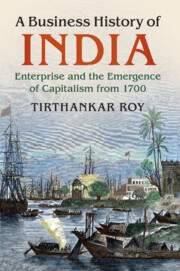Book contents
- A Business History of India
- A Business History of India
- Copyright page
- Dedication
- Contents
- Figures
- Maps
- Tables
- Boxes
- Preface
- 1 Introduction
- 2 The Baseline at 1700
- 3 The Indian Ocean Sphere: 1700–1850
- 4 Capital and Empire (1850–1930)
- 5 Capital and Empire (1850–1930)
- 6 State and Industrialisation: 1930–1950
- 7 State and Industrialisation: 1950–1980
- 8 Revival: 1980–2000
- 9 Capital and Globalisation: 2000–2015
- 10 Conclusion
- References
- Index
1 - Introduction
Published online by Cambridge University Press: 20 March 2018
- A Business History of India
- A Business History of India
- Copyright page
- Dedication
- Contents
- Figures
- Maps
- Tables
- Boxes
- Preface
- 1 Introduction
- 2 The Baseline at 1700
- 3 The Indian Ocean Sphere: 1700–1850
- 4 Capital and Empire (1850–1930)
- 5 Capital and Empire (1850–1930)
- 6 State and Industrialisation: 1930–1950
- 7 State and Industrialisation: 1950–1980
- 8 Revival: 1980–2000
- 9 Capital and Globalisation: 2000–2015
- 10 Conclusion
- References
- Index
Summary
The Book
For almost a quarter of a century now, Indian economy has grown at an impressive pace. Private enterprise has led this growth. In the process, Indian companies have had to absorb new technologies and management ideas, reinvent or discard tradition, invite international partners, and become international themselves.
What Indians are now living through is only the latest in a series of episodes that reshaped capitalism in the region. In the 1950s and 1960s, businesses had to adapt to a socialist and protectionist environment. A hundred years before that, businesses responded to the opportunities and risks created by free trade in the British Empire. And before the British Raj came into being, businesses dealt with the collapse of the Mughal Empire in the north, and the rise of the East India Company on the southern coast. Each one of these episodes was organically linked with the others.
This is a business history of India in the last 300 years. The field is rich and well developed. But this book aims to be different in two ways. First, it offers a connected narrative, that is, it links different times, major episodes, Indian history with world history, and economic history with the experience of firms, families, and communities. While writing a connected story, the book also answers the question: Is there something distinctly Indian about Indian business history? Conventional answers to the question consider unique features of Indian society such as caste or India's subordinate position in the British colonial empire in the nineteenth century. Some may even deny the usefulness of the question. This book is different. It does have a leitmotif. And the leitmotif is neither caste nor colonial rule.
A business history is an interesting enterprise because it tells us how capitalists obtain the resources that are essential for capitalism to grow. These resources include capital, technology, trust, managers, organisation, and skills. For most of the years covered in the book, some of these resources were scarce in India. For example, compared with Europe, where financial and commercial capitalism modernised in parallel roughly from the 1600s, trade and industry expanded in nineteenth century India in the presence of limited financial development and high interest rates. Capitalism developed, anomalously, in a region where capital was in short supply.
- Type
- Chapter
- Information
- A Business History of IndiaEnterprise and the Emergence of Capitalism from 1700, pp. 1 - 21Publisher: Cambridge University PressPrint publication year: 2018



